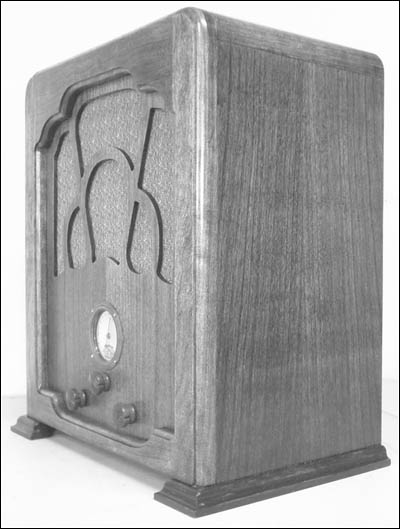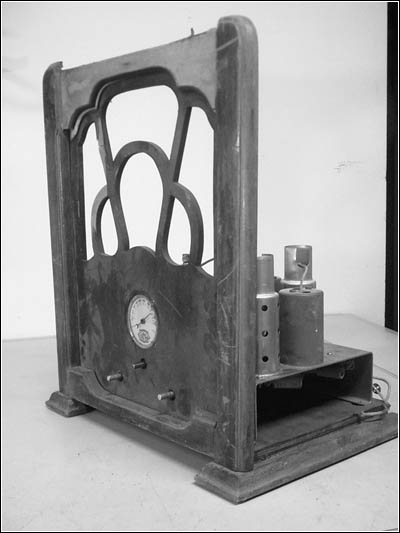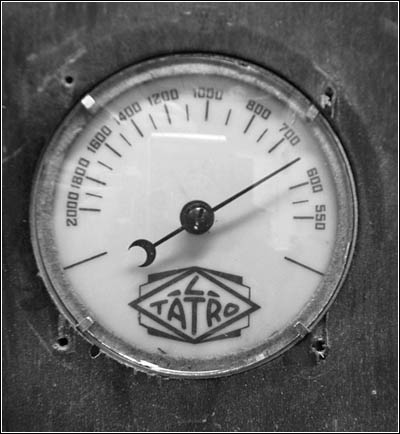Of Old Radios And Related Items--Published Monthly
L'Tatro Radios
BY LAUREL "OZZIE" AASGAARD
Web Edition
Sometimes an old barn tells a sad story when it has been the storage place for antique radios. However, Ozzie Aasgaard was able to salvage at least one interesting set from such a place. Every item counts in the ongoing saga of radio preservation. (Editor)
The radio described in this article and shown restored in Figure 1 is a L'Tatro Model 465. The "4" in the model number indicates it is a 4-tube model. The set originally had a 6VDC "Elkonode" power supply, but it was missing. As a result, I installed a 117VAC transformer, a vacuum tube rectifier, and new filter capacitors for the required voltages. All other components are original, and the restored radio plays very well with a long wire antenna, or aerial, as it was called back then.
Figure 1. The restored L'Tatro Model 465 in its repaired and refinished cabinet belies its "as-found" condition.This Model's History
Over the years I made several offers to buy some vintage radios from an old-timer in our community who was known as an electronic wizard of his time. He repaired home radios from their earliest days through the golden years of AM. That was an era before "throw-away," when electronic repair was not only economical but an absolute necessity. This was especially true during the years of World War II, when new radios were not made for civilian use.
Figure 2. Shown are the skeletal remains of the L'Tatro Model 465 farm radio.But, the old-timer refused my offers saying he planned to repair and restore them himself. He lived in nearly hermit-style conditions, providing better shelter for his cache of radios than he did for himself.
In his later years, he was relocated through an eminent domain buy-out by the highway department, and his radios were moved to the hayloft of a barn at his new location. Even then, he declined my offers to buy any of his radios, still insisting he was going to restore them.
After his death in his mid-nineties, his family offered his radios to anyone who would remove them from the barn. Unfortunately, after many years under a leaky roof and layers of pigeon droppings, his collection of radios was pretty much ruined.
However, amid this mess I found remnants of a radio of a brand I hadn't heard much about. It was a L'Tatro, the subject of this article. Very few parts of the wood cabinet were intact as can be seen in Figure 2. The chassis was in fair shape with some parts missing, but the dial was in excellent condition as seen in Figure 3.
L'Tatro Radios
L'Tatro radios were made in Decorah, Iowa. They would be considered "farm radios" because almost all models were designed to operate from either a 6VDC rechargeable battery or from a 32VDC farm electrical system. Rider's Perpetual Troubleshooter's Manuals, Volumes 4 through 10, contain data on 54 models, with the only differences among them being whether they were table or console models. I believe the name has sometimes been incorrectly formatted, as I have seen it as L. Tatro. This may have been the case when the Rider manuals were published, because the data is indexed under the letter "T" rather than the letter "L."
Figure 3. The radio's dial seems to have survived better than the cabinet.Most of the 32VDC models had the tube filaments in series, a few operated with 32VDC plate voltage, and some used 45-volt B batteries. However, most of the 6VDC and 32VDC sets were designed with self-rectifying vibrators trademarked "Elkonode" to provide the B+. A few models had vacuum tube rectifiers. Of the 54 models listed in the Rider volumes, only five were designed to operate from a 117VAC source, and even they were convertible to either 6VDC or 32VDC with minor jumper or plug-in modifications.
Reference:
Rider, John F. Perpetual Troubleshooter's Manuals, Volumes 4 through 10. New York: John F. Rider, Publisher.
(Ozzie Aasgaard, 1047 Highwood Circle, Detroit Lakes, MN 56501-4329)
Ozzie Aasgaard is retired from a lifetime occupation in electronics, which included teaching radio in the military service. While owning and operating a Land Mobile Radio Service business, he also taught Electronic Technology at a Minnesota technical college for several years. He repairs and restores vintage radios and collects any pre-World War II radios, though he favors cathedrals and tombstones. He prefers the name "Ozzie" to his first name which often causes mail to be sent with the prefix "Ms."
| [Free Sample] [Books, etc., For Sale] [Subscribe to A.R.C./Renew] [Classified Ads] [Auction Prices] [Event Calendar] [Links] [Home] [Issue Archives] [Book Reviews] [Subscription Information] [A.R.C. FAQ] URL = http://www.antiqueradio.com/Jul06_Aasgaard_LTatro.html Copyright © 1996-2006 by John V. Terrey - For personal use only. Last revised: July 1, 2006. For Customer Assistance please contact ARC@antiqueradio.com or call (866) 371-0512 toll free Pages designed/maintained by Wayward Fluffy Publications
Antique Radio Classified |


